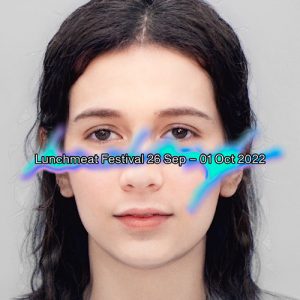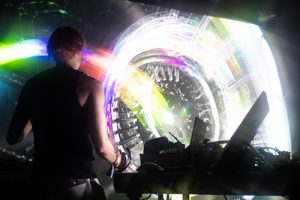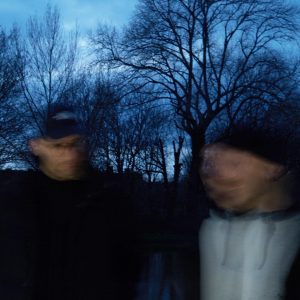
“We were fascinated by how the combination of light and sound in a space would influence the people inside of it,” says Paraadiso on their audiovisual experimentations. “Heightening the senses, and sometimes—given the right circumstances—conveying a sense of collectivity and care for one another.”
We are talking in the lead up to Prague’s Lunchmeat Festival, for which the London-based duo are preparing a live set around their work which they describe as “a balanced combination of organised chaos.” Consisting of Italian-born artists TSVI (aka Guglielmo Barzacchini) and Seven Orbits (aka Matteo Zamagni), Paraadiso emerged in 2021 with the debut release Unison on Shanghai’s SVBKVLT label. Dropped as a double LP, it contains an expansive sonic palette, ranging from the bouncing binaural electronics of ‘Liquid Matter’, to the glistening rave arpeggios, choral atmospheres, and stuttering percussive interventions of ‘Aerial Dome’. There are darker moments too, like the white noise drones and hi-pass filtered breaks that underpin the moody ‘Berserk’.
Conceived during the isolation of the pandemic, Unison coalesces around a theme of music’s relation to collective consciousness and gathering, giving the duo’s live incarnations this year an added weight of both joy and tension. “We’re grateful that these spaces exist given the fragile state of the world right now,” Paraadiso explain in relation to our return to the club. “It feels like everything is back to normal on the surface, although the pandemic, climate, wars, and politics have contributed to this fragile and fluctuating economy. It has taken a huge toll on independent organisations and promoters in the event industry.”

We spoke on topics of ceremony and ritual, reciprocal care and technology’s effect on the multidisciplinary, being themes that circulate around the duo’s output.
**Your record Unison is inspired by ancient rituals, gatherings and ceremonies. Can you tell me about where your interest in collective consciousness came from? In particular I’m keen to know about the Italian folk music influences you mention.
Paraadiso: The interest began [after a] deeper exploration of indigenous cultures around the world, and observing that each in their cores had a vast knowledge of the natural world and the interdependence of the system we inhabit, as well as the cosmos. This knowledge was often spread orally via ceremonies and rituals, which often combined repetitive sounds, dance, fire and spoken word. In these settings participants could have felt a heightened state of consciousness, sometimes via the hypnotic combination of fire—a core element in many ancient traditions—rhythm and voice. And in some other circumstances thanks to the traditional local medicine, different in each culture but usually derivative of plants. We tried to combine visuals and sound to stimulate a similar experience.
We began embracing Italian traditions after moving away from our country. Progressively we were able to see it in a new light, and particularly see the relationship with electronic music—repetitive rhythms, polymetres, patterns from pizzica or tammurriata for instance—and choral vocals from the Middle Ages, being used in ancient rituals as a vehicle of communication.
**How has your thinking on these ideas developed as we’ve returned to social gatherings since the pandemic?
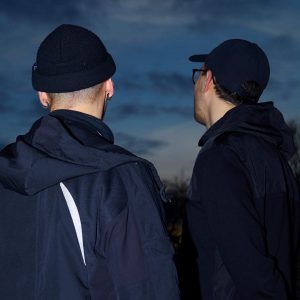
P: In the midst of the lockdown of 2020 when making the album we had in mind this very special feeling of relatedness mentioned above. Human interaction is profoundly social, our everyday life does not take place in isolation but constantly requires our engagement with other people. This feeling of relatedness, reciprocal care, and collectivity, is rare and not normally experienced on a day-to-day basis, especially among strangers in big cities. It can be experienced sometimes in music venues but not exclusively, it could also be felt in a religious building, a stadium or a square. Many people during the pandemic realised how it feels to be alone for a prolonged period of time despite the use of our devices. As social beings we need physical interaction, and these spaces can be beneficial to foster new relationships and connections.
**I was wondering about your thoughts on the growing prevalence of audiovisual elements in club and live experiences nowadays?
P: Technology in the past few decades has been getting more and more accessible to people. Together with computing power growing two-fold every year and people being more multidisciplinary, it has led to the creation of a large volume of mixed media works which sit well in the context of a festival. Audio and visuals in art have always been connected, but thanks to computers it has been possible to relate them even more closely to one another. Festivals like Lunchmeat are at the forefront of this ever-growing relationship.
**Matteo (Seven Orbits) you also work in visuals and Guglielmo you have a club-oriented project in TSVI—how have these two practices informed Paraadiso?
P: As Paraadiso it felt right to create a seamless AV work from the start. TSVI’s musical background is on the record as intricate drums and topline melodies which showcased what at the time were his influences, such as trance, trap and ambient. This together with Seven Orbits’s process and interests in noise, polyrhythms, and off grid compositions, created a balanced combination of organised chaos.
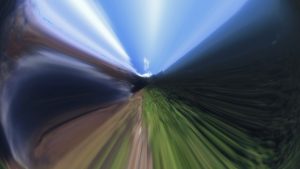
Matteo, given his background in creative tech, visuals and lately music, has developed a tool that seamlessly connects film and audio into a real-time, audio-responsive and interactive environment, where logic systems connect and bridge communication between multiple softwares, informing one another.
In this case Ableton is triggering video clips, cuts, cues, effects, 3D elements and more inside two graphics softwares TouchDesigner and Unreal Engine. This system is autonomous but can function alongside user input, so in this sense it was a total collaboration between man and machine. In a live context Guglielmo has taken care of the music side while Matteo the visuals.
**How do you two approach your collaborative process more generally?
P: We’ve been working together for many years now, collaborating mostly in audiovisual works but we’ve never combined it into a cohesive project until now. So it was an organic progression of our ongoing collaboration. When we made the album, or in general when making music together, we had two sessions of Ableton Live on each computer linked together. This removed many constraints and helped us create very spontaneously one next to the other, as if we were in a jam session.**
Paraadiso performs as part of Lunchmeat Festival 2022: See You Dancin’, on September 30, 2022.
